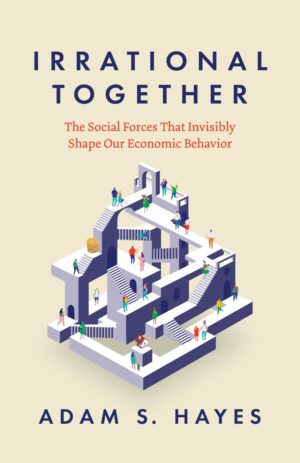Irrational Together: The Social Forces That Invisibly Shape Our Economic Behavior. 2025. Adam S. Hayes. The University of Chicago Press, Ltd., London
Investment professionals who keep abreast of economic research know that the behavioral school has exposed flaws in conventional theory based on homo economicus, a hypothetical being capable of perfectly rational decision-making. A familiar illustration of the gap between that depiction and reality is the substantially higher percentage of employees who participate in 401(k) plans when given the choice to opt out rather than opt in; simply framing the decision differently produces a different outcome.
Adam S. Hayes’s Irrational Together makes the case that the behavioral critique does not go far enough. Rather, it remains focused on the cognitive psychology of the individual, overlooking socially driven deviations from traditionally defined rational economic choices.
Hayes, a professor of sociology at the University of Lucerne with previous experience as an equity derivatives sales trader and licensed financial advisor, describes numerous ways in which social and cultural norms cause people to diverge from straightforwardly obtaining the maximum personal benefit for the least possible expenditure.
He presents survey findings involving decisions such as whether to save money by downsizing from a house that includes a spare bedroom used by one’s mother-in-law on occasional weekend visits. Respondents’ answers varied according to what they were told about how harmonious the relationship is between the homeowner and the mother-in-law. When asked the basis for their answers, however, the overwhelming majority cited only financial considerations.
Lest investment professionals imagine they are immune from having their financial decisions skewed by social factors, Hayes cites a study involving in-group bias that found that ostensibly self-interested venture capitalists prefer to fund startups of teams with professional backgrounds and education similar to their own. This is just one of many striking research findings highlighted in Irrational Together, including:
Notwithstanding the attention heaped on the behaviorists’ nudging techniques, a meta-analysis covering more than 200 published studies found that the nudging backfired in some instances, leaving an overall effect of zero.
Field studies produced evidence that the widely reported gender-based disparity in risk tolerance is not entirely biologically determined but also reflects differences in socialization of males and females.
Research over the past two decades has found that the left-brained/ right-brained dichotomy enshrined in pop psychology has no scientific basis.
An analysis of the self-managed portfolios of 70,000 investors documented a seven-percentage-point-per-annum average underperformance of the S&P 500 Index.
The research Hayes draws upon includes much of his own meticulous work. For instance, in his examination of the robo-advisor phenomenon, he pored over regulatory filings, interviewed providers, and opened accounts with several firms, posing alternatively as a thirty-five-year-old and a fifty-year-old.
Attesting to the fact that there are no perfect books, Hayes attributes to baseball immortal Yogi Berra the adage, “It’s tough to make predictions, especially about the future.” The indispensable Quote Investigator reports on the contrary, “[C]urrent evidence indicates that this comical proverb was first expressed in Danish, and the author remains unknown.”
Nevertheless, Irrational Together enriches our understanding of the collective impact of economic decisions. An intriguing section near the end ponders the paradoxical undermining of rational outcomes that could result from increasingly widespread application of modern portfolio theory via robo-advisors. Reading this book will provide investment professionals who deal with private clients valuable tips to help them avoid damage to their performance, not only through decisions that are irrational because of innate programming of the human brain, but also through those that arise from social conventions, culture, religion, and ideology.
If you liked this post, don’t forget to subscribe to the Enterprising Investor.
All posts are the opinion of the author. As such, they should not be construed as investment advice, nor do the opinions expressed necessarily reflect the views of CFA Institute or the author’s employer.
Image credit: ©Getty Images / Ascent / PKS Media Inc.
Professional Learning for CFA Institute Members
CFA Institute members are empowered to self-determine and self-report professional learning (PL) credits earned, including content on Enterprising Investor. Members can record credits easily using their online PL tracker.
